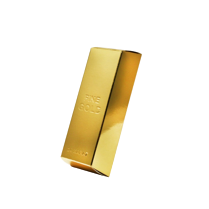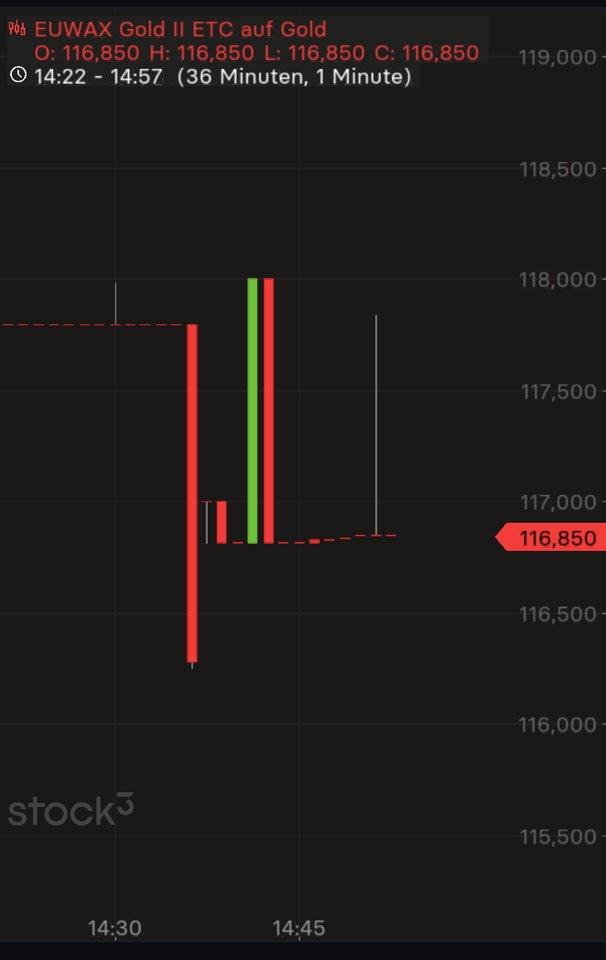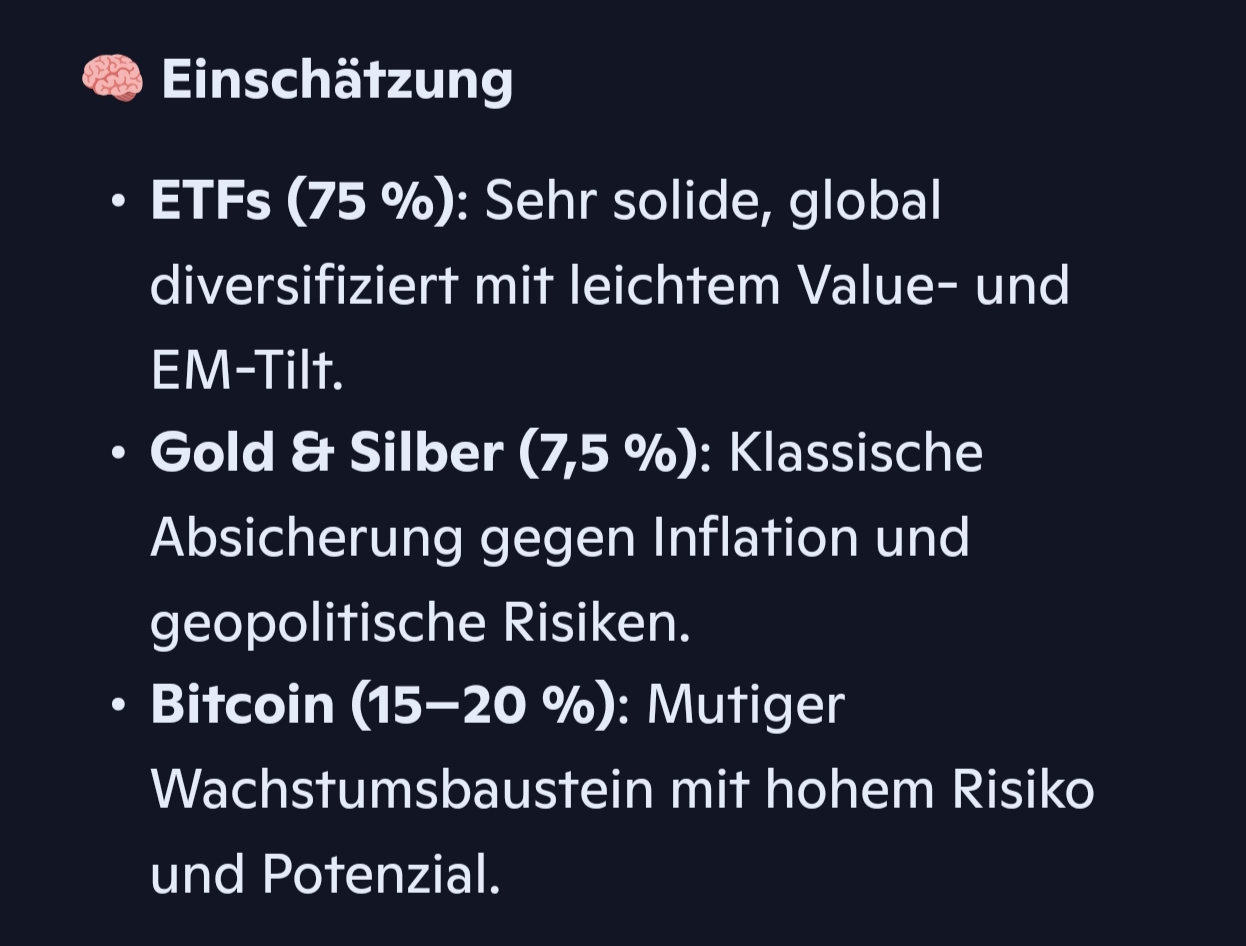
EUWAX Gold II
Price
Debate sobre EWG2
Puestos
119Unusual movement in EuwaxII Gold
$EWG2 (+0,67 %) has already been down around 1% for half an hour, at least the selling price. The spread has widened to almost 2%.
$IGLN (+0,6 %) is close to 0%.
Something is wrong. This is not normal.
Risk of failure? Delivery problems?
To all $EWG2 (+0,67 %) I would advise all holders to keep a closer eye on the next few days and possibly swap into other ETCs.
Your Epi


The path to financial freedom
My path to financial freedom. My investment horizon is around 15 years.
- Monthly savings rate 2600 Euro
- 1000 Euro ETF savings plan
- 1150 Euro individual shares
- 400 Euro BTC savings plan + 20000 Euro cash still invested to reach 20 % of the portfolio
- 50 Euro P2P Go&Grow
Target weighting
30 % ETF $SP20 (-0,72 %)
30 % shares
$AMD (-0,57 %)
$ASML (-0,27 %)
$SHOP (-2,39 %)
$NOW (+0,88 %)
$NU (+0,48 %)
$META (-0,13 %)
$FTNT (+0,54 %)
$ANET (+0,58 %)
$NFLX (-0,02 %)
$APP (+1,54 %)
$CRWD (-0,96 %)
20% Bitcoin $BTC (-1,51 %)
10% gold $EWG2 (+0,67 %)
5% P2P Bondora Go&Grow
5% Cash cushion $ERNX (+0,06 %)
the strategy is always individually adapted.
30% GTAA
30% 3xGTAA
30% 2xSpytips
10% cash
= approx. 2,3%pM
= 7080€pM gross
= 5200€pM net
= Financial freedom today.
But I'll probably always be the Don Quixote of investment strategies. 🤷
A presentation on the topic of gold
For those who have no plans today,
Aswath Damodaran (if you don't know him, please google him) has made a short but very precise analysis of gold as an investment.
Highly recommended!
https://youtu.be/FdlCocXHnMs?si=TyIjsezV_5QwLTXb
For those who prefer to read it:
https://aswathdamodaran.blogspot.com/2025/11/a-golden-year-2025-golds-price-surge.html?m=1
Portfolio strategy for the coming months
I'm still studying and whenever I get a fixed salary, I get paid first. The last few months I've invested riskily and without a salary. Besides that, I want to bring some kind of order and automatism. My portfolio strategy is risk-taking, but still focused on growth with stability. I still have plenty of time, hopefully. The percentages are not set in stone, but the portfolio should already have a safe haven.
My current budget is €250:
50% in $HMWS (-0,13 %) = 125€
16% in $BTC (-1,51 %) = 40€
4% in $ETH (-4,34 %) = 10€
10% in $EWG2 (+0,67 %) = 25€
20% in various shares = 50€
Gladly feedback!
I would only go into gold with 4% and shift the 6% to the MSCI World.
And then only add 40 euros to equities and increase the MSCI World. Then you're at 60/16/4/4/16.
Sounds more stable for the start. If it were up to me, I would even set the equity position to 10% and go 66/16/4/4/10 😉
Portfolio allocation
This will be my future portfolio allocation and is almost already like this, only small changes need to be made.
ETFs (75%)
$VWCE (-0,16 %) (85%)
$TDIV (+0,56 %) (10%)
$EIMI (-0,59 %) (5%)
Crypto (20%)
Commodities (5%)
________________________________________
I will also pick out a few individual stocks. But I'll only track them separately and see how they perform in a few years. I will probably opt for the following, which are already very popular in the community. $IREN (-0,83 %) , $RKLB (+10,77 %) , $TTI (+4 %) , $WM (+0,77 %) , $INT , $SOFI (+0 %) , $NU (+0,48 %) and $DRO (-10,15 %) . I will invest a total of around €5K in these shares.
What do you think of the portfolio?


Gold instead of money market in the children's portfolio?
Hello everyone,
After a long time as a silent reader, I would like to share my first post today - with a question that is currently on my mind.
My children benefited early on from an inheritance. I invested the capital I received in a long-term, broadly diversified portfolio:
- 65 % in $WEBN (-0,29 %) - as a low-cost basic investment
- 20 % in $WTCH (-0,78 %) - as a growth-oriented addition.
- 15 % in the $XEON (+0,01 %) - originally intended as a liquidity reserve. It seemed sensible to me, although I would never have been able to say what this liquidity was being held for...
As my children won't need the money in the money market ETF for the next few years, I'm now thinking about reallocating this proportion. At the moment I'm flirting with a gold ETC - e.g. $4GLD (+0,58 %) or $EWG2 (+0,67 %) .
My reasoning: Gold has become much more expensive recently, which makes me wonder: Is now even a good time to get in? Or would a staggered purchase over several months (keyword: DCA) make more sense in order to reduce the risk of a short-term price decline?
My questions to you:
How sensible is gold as a long-term addition (investment horizon: initially 10-15 years) in a child's portfolio?
Would you completely reallocate the money market portion now - or would you rather invest in a staggered manner (DCA)?
I look forward to your opinions! Thank you already for your input - and it's great to be actively involved now!
Best regards
Joo
BYE-BYE EXPENSIVE PET INSURANCE? 🐾💸
I'm starting my DIY pet health fund strategy to cleverly manage vet costs myself, I thought it would be much more fun to be my own insurer.
After reviewing and calculating the costs, I came to the conclusion that I would pay €30-40/month for my cat, assuming she has a life expectancy of 13-15 years, into a defensive portfolio instead of a monthly insurance premium.
From the age of 8 - 10, I expect the risk of more frequent treatments and high vet costs to increase enormously as my cat gets older.
Of course, I am aware that high costs can also arise much earlier, but you don't always have that when you build up reserves for a possible event in the future.
📊 I would start with this breakdown:
🛡️60% defensive (money market & short bond ETFs) = capital preservation & liquidity
⚔️40% offensive (equity & gold ETFs) = growth & inflation protection
- 20% $IS3Q (+0,17 %)
10% $IWDA (-0,17 %)
10% $EWG2 (+0,67 %)
🏦 Payout rules:
- Deductible: €250 - €300, anything above that I will take out of the portfolio so as not to put too much strain on the capital stock.
- Liquidity buffer: at least €1,500 p.a. should be available in the defensive part of the portfolio.
🚨 The whole thing should give me more control and better returns in the long term - without the profit margin of an insurance company.
💬 Your opinion is not only wanted but also important. What do you think of such a DIY model? Risk or opportunity?
#DIYinsurance
I had considered something similar for our dog, but "her" reserves are currently still too small for no insurance at all. 😅
Portfolio and future plans
Hello everyone,
In this post I would like to talk a bit about my portfolio and my journey so far.
I started investing through Oskar when I was 16, when I started my apprenticeship as a chef. At the beginning of this year, I finished my apprenticeship and decided to take the whole thing into my own hands - away from Oskar and towards my own research and portfolio.
I'm currently 20 years old and save €1,000 a month for my portfolio.
I bought a motorcycle in the summer, which set me back a bit financially. As a result, my portfolio value is currently below €20,000 again.
My strategy is currently a classic buy-and-hold strategy consisting of gold, Bitcoin, an all-world ETF and a few individual shares in which I have long-term confidence.
About my portfolio:
40 % $SPYI (+0,03 %)
30 %$BTC (-1,51 %)
30 % $EWG2 (+0,67 %)
(@Epi thanks for your tips on gold allocation)
I also hold "smaller" positions in:
$GLXY (+0,79 %) - 2.126 €
$NBIS (+1,26 %) - 500 €
$MTM (+0 %) - 471 €
$IREN (-0,83 %) - 188 € (after partial sale)
My plan is a partial sale of $GLXY (+0,79 %) in the first quarter of 2026, depending on how the share reacts to Helios. At $NBIS (+1,26 %) and $MTM (+0 %) I will set a trailing stop loss after a good run. $IREN (-0,83 %) I will let it continue to run, as my original position has already been realized.
In the long term, I plan to acquire a property or similar investment for rental purposes. I recently considered taking over a self-service car wash, but this failed due to the current owner's lack of interest.
A home of my own is not currently on my list, as there are no plans to have children in the near future.
My retirement is still a long way off, so I'm not thinking too much about a final portfolio structure at the moment. At the moment, my focus is on investing continuously, learning and growing my capital over the long term.
I invest because I started early on to make my money work for me. Mistakes are part of the process, but the long-term goal remains clear: building wealth with a focus on independence and personal responsibility.
I welcome feedback and am happy to accept tips or suggestions for improvement - especially from those who have been investing for a while or are pursuing similar strategies.
~Philipp
Third and last chance
Gold therefore accounts for around 3% of my portfolio, like Bitcoin $BTC (-1,51 %) in my portfolio. That's enough diversification for me.
Valores en tendencia
Principales creadores de la semana















